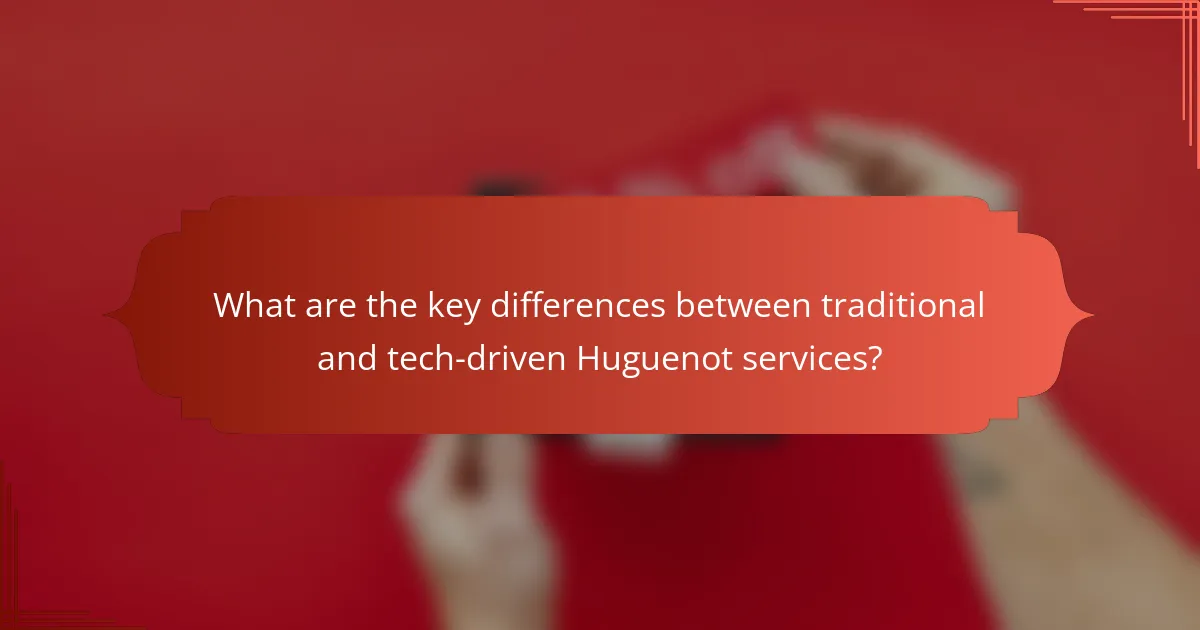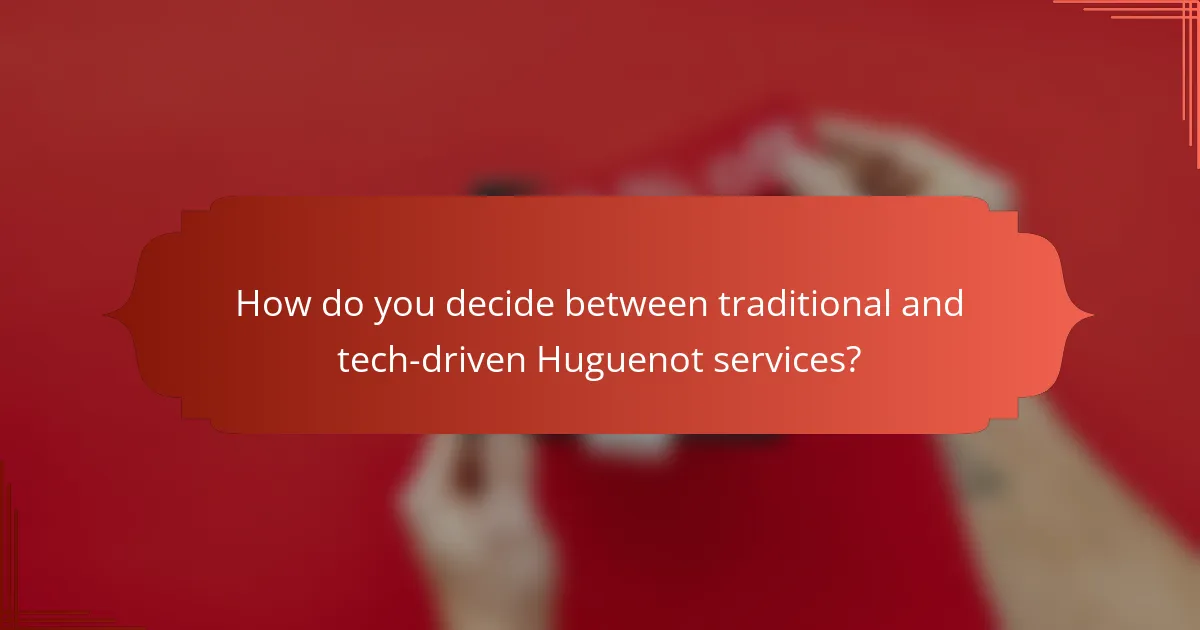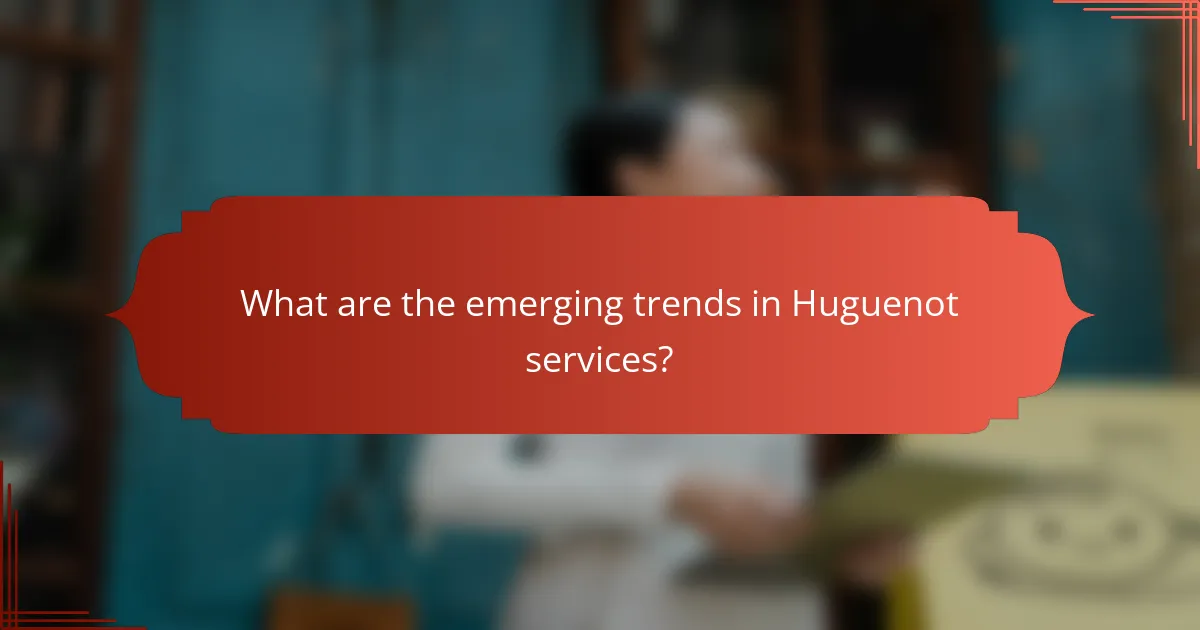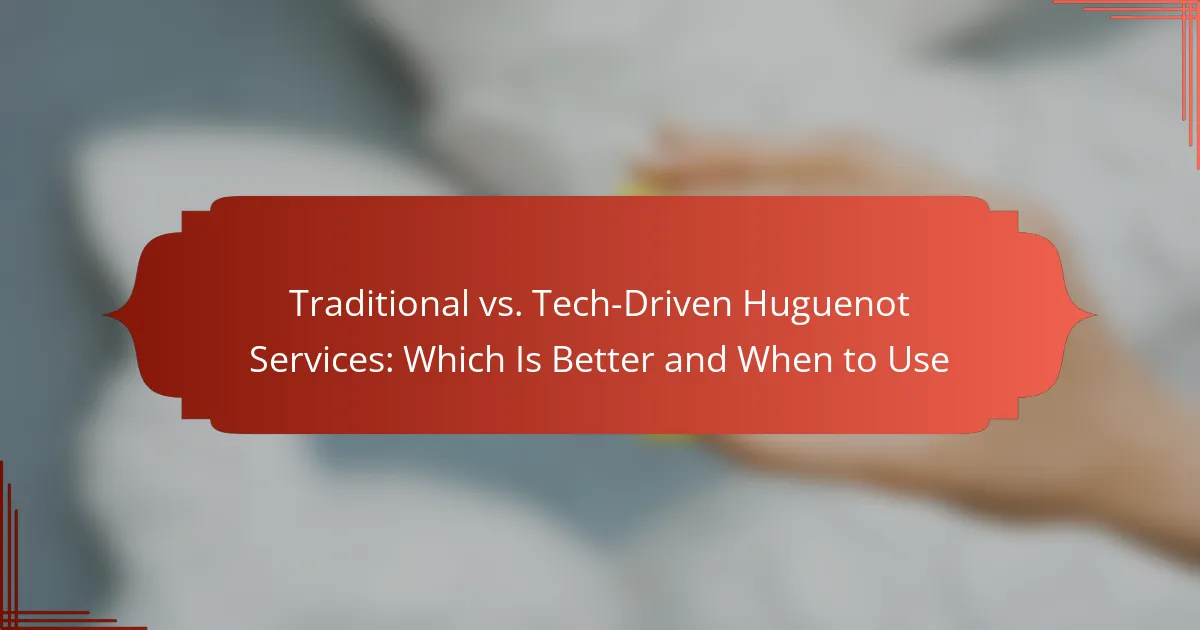When considering Huguenot services in Ireland, it’s essential to weigh the benefits of traditional versus tech-driven options. Traditional services emphasize personal interaction and community engagement, making them ideal for those who value familiarity and comfort. In contrast, tech-driven services offer efficiency and cost savings, catering to situations that require quick turnaround and accessibility.

What are the best Huguenot services in Ireland?
The best Huguenot services in Ireland typically include a mix of traditional and tech-driven options, catering to various needs. Traditional services focus on personal interactions and community engagement, while tech-driven services leverage modern technology for efficiency and accessibility.
Traditional Huguenot services
Traditional Huguenot services in Ireland often emphasize face-to-face interactions and community involvement. These services may include local church gatherings, community events, and personal counseling sessions, fostering a strong sense of belonging.
Examples of traditional services include Sunday worship, prayer meetings, and community outreach programs. These gatherings allow individuals to connect with one another and strengthen their faith through shared experiences.
Tech-driven Huguenot services
Tech-driven Huguenot services utilize digital platforms to enhance accessibility and convenience. These services may include online worship sessions, virtual counseling, and mobile apps for community engagement, making it easier for individuals to participate regardless of their location.
For instance, many churches now offer live-streamed services or recorded sermons that can be accessed anytime. Additionally, social media platforms are often used to keep the community informed and connected.
Comparative benefits
When comparing traditional and tech-driven Huguenot services, each has distinct advantages. Traditional services foster personal connections and a sense of community, which can be vital for emotional and spiritual support.
On the other hand, tech-driven services offer flexibility and accessibility, allowing individuals to engage with their faith on their own terms. For those who may have mobility issues or live far from their community, tech-driven options can be particularly beneficial.
Ultimately, the choice between traditional and tech-driven services depends on individual preferences and circumstances. A balanced approach that incorporates both can provide a comprehensive support system for Huguenots in Ireland.

When should you choose traditional Huguenot services?
Traditional Huguenot services are best suited for individuals or families who value personal interaction and community involvement. These methods often emphasize face-to-face communication and established practices, making them ideal for those seeking a more familiar and comforting experience.
Specific use cases
Traditional Huguenot services are particularly effective for significant life events such as weddings, funerals, and baptisms. These occasions often benefit from the personal touch and cultural significance that traditional methods provide.
Additionally, individuals who are less comfortable with technology or who prefer a slower pace may find traditional services more accessible. This approach is also beneficial in rural areas where technology may not be as readily available.
Benefits of traditional methods
One of the primary benefits of traditional Huguenot services is the strong sense of community they foster. Participants often feel more connected to their heritage and to one another, which can enhance the overall experience.
Moreover, traditional methods typically involve established rituals and practices that can provide comfort and familiarity. This can be particularly important during emotionally charged events, where the structure of tradition can offer solace.
Cost-wise, traditional services may also be more predictable, as they often follow standard practices without the additional expenses associated with technology-driven options. This can make budgeting easier for families planning significant events.

When is it better to use tech-driven Huguenot services?
Tech-driven Huguenot services are preferable when speed, efficiency, and cost savings are priorities. These services leverage technology to streamline processes, making them ideal for situations that demand quick turnaround and reduced expenses.
Efficiency and speed
Tech-driven Huguenot services excel in efficiency and speed by automating tasks that would typically require manual intervention. For example, digital platforms can process requests in a matter of minutes, compared to traditional methods that may take days. This rapid processing can be crucial in time-sensitive situations.
To maximize efficiency, consider using online platforms that offer real-time updates and notifications. This way, you can track progress without needing to make frequent inquiries, saving both time and effort.
Cost-effectiveness
Utilizing tech-driven Huguenot services can lead to significant cost savings. Automation reduces labor costs and minimizes errors, which can be expensive to rectify. For instance, using a digital service may cut costs by a substantial percentage compared to traditional methods, especially for high-volume transactions.
When evaluating cost-effectiveness, compare the fees associated with tech-driven services against those of traditional options. Look for platforms that offer transparent pricing structures to avoid hidden fees, ensuring you get the best value for your investment.

What are the key differences between traditional and tech-driven Huguenot services?
Traditional Huguenot services typically rely on in-person interactions and established practices, while tech-driven services leverage digital tools for efficiency and accessibility. Understanding these differences can help individuals choose the right approach based on their needs and circumstances.
Service delivery methods
Traditional Huguenot services often involve face-to-face meetings, where clergy and community members engage directly. This method fosters personal connections but may limit accessibility for those unable to attend in person.
In contrast, tech-driven services utilize online platforms, allowing for remote participation and broader reach. These services may include video conferencing, online resources, and digital communication, making them more convenient for individuals with mobility issues or those living far from service locations.
Customer experience
The customer experience in traditional Huguenot services is characterized by a strong sense of community and personal interaction. Participants often feel a deeper emotional connection through shared rituals and communal gatherings.
Tech-driven services, while efficient, may lack the same level of personal touch. However, they can enhance the experience through interactive features, such as live chats or online forums, enabling participants to engage with the community in new ways. When choosing between the two, consider the importance of personal connection versus convenience in your own experience.

How do you decide between traditional and tech-driven Huguenot services?
Choosing between traditional and tech-driven Huguenot services depends on your specific needs, preferences, and the context of the service. Traditional methods may offer a personal touch, while tech-driven options can provide efficiency and accessibility.
Criteria for selection
When selecting between traditional and tech-driven Huguenot services, consider factors such as the nature of the service, the target audience, and the desired outcomes. For instance, if personal interaction is crucial, traditional services may be more suitable. Conversely, if speed and scalability are priorities, tech-driven services could be the better choice.
Evaluate the resources available, including budget and technology access. Traditional services often require more time and personnel, while tech-driven services may incur software or platform costs. Understanding these criteria will help streamline your decision-making process.
Decision-making framework
A practical framework for deciding between these service types involves assessing the specific situation and aligning it with your goals. Start by identifying the key objectives you want to achieve, such as community engagement or operational efficiency.
Next, weigh the pros and cons of each approach. For example, traditional services may foster deeper connections but can be limited by geographic reach. Tech-driven services can enhance outreach but may lack the personal touch. Create a checklist to evaluate each option against your objectives, and consider piloting a small-scale implementation to test effectiveness before fully committing.

What are the emerging trends in Huguenot services?
Emerging trends in Huguenot services reflect a blend of traditional methods and modern technology, adapting to changing consumer demands and technological advancements. Key trends include the integration of artificial intelligence, shifts in customer preferences towards more personalized experiences, and the rise of hybrid service models that combine both approaches.
Integration of AI in services
The integration of AI in Huguenot services enhances efficiency and personalization. AI tools can analyze customer data to tailor services, predict needs, and streamline operations, thereby improving the overall experience. For instance, chatbots can handle inquiries 24/7, providing immediate assistance and freeing up human resources for more complex tasks.
When implementing AI, consider the balance between automation and human touch. While AI can manage routine interactions, personal connections remain vital in service industries. Ensure that there are options for customers to engage with human representatives when needed.
Shifts in customer preferences
Recent shifts in customer preferences indicate a strong desire for personalized and convenient services. Clients increasingly expect tailored experiences that cater to their unique needs and preferences, often facilitated by technology. For example, many customers now prefer online booking systems that allow them to choose specific services at their convenience.
To adapt to these preferences, Huguenot service providers should invest in customer relationship management (CRM) systems that track individual client history and preferences. This data can be used to offer personalized recommendations and improve customer satisfaction.
Future of hybrid service models
The future of Huguenot services is likely to feature hybrid models that merge traditional and tech-driven approaches. These models allow for flexibility, catering to diverse customer preferences while maintaining the personal touch that many clients value. For example, a service might offer both in-person consultations and virtual meetings, allowing clients to choose their preferred method of engagement.
When developing hybrid models, consider the logistics of integrating both service types. Ensure that staff are trained to handle both in-person and digital interactions effectively. Additionally, gather feedback from clients to refine these models continuously and meet evolving expectations.
